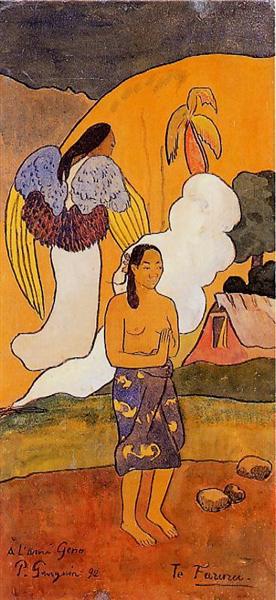Description
Paul Gauguin, one of the most emblematic figures of post -impressionism, is known for his particular colorist approach and his bold use of form and symbolism. In "The meeting" (1892), the work reveals both visual and theme complexity that invites a deep contemplation. The painting, representative of Gauguin's stylistic evolution, encourages a dialogue between Western culture and Polynesia, contexts that the artist explored with great interest during his residence in Tahiti.
In "the encounter", the composition is articulated around a visual and spiritual encounter between two human figures, which also intertwine with an lush tropical background. The work is marked by the presence of an abundant flora, whose vibrant green leaves contrast in a stunning way with the most overwhelming background and warm shades. This color choice not only establishes a sense of geographical location, but also emphasizes the emotional psyche. The warm tones that predominate at the bottom of the image suggest a feeling of intimacy, while the deepest blue in the background evoke an almost mystical vastness. The juxtaposition of both elements breaks the borders between the physical and the spiritual, suggesting the idea that this "encounter" is both a crossroads on earth and a transcendental experience beyond it.
The characters in "The encounter" are clearly delineated, with a symbolic burden that transcends their physical representation. Gauguin rarely limited himself to a mere transcription of reality; Its purpose was often oriented towards a representation of emotional and spiritual experience. The figures have stylized characteristics that resemble the iconography of non -western cultures, in line with the artist's interest in primitivity and the exotic. These figures, located in an almost dreamlike context, create an atmosphere of mystery, leaving the viewer to reflect on the relationship between the characters: Are partners, lovers, or representations of different cultures in dialogue?
A fascinating detail of the work is the way in which Gauguin uses color not simply as a means of representation, but as a narrative element. The rich and saturated palette evokes sensations that transcend to the literal meaning of the objects represented. Deep shadows and bright contrasts serve to intensify the emotional load of the image, guiding the viewer towards a sense of discovery.
The historical context of the work is equally significant. In 1892, Gauguin was deeply involved in the search for an artistic identity that would question the established norms of academic painting. His desire to escape the conventions of European society led him to Tahiti, where he was attracted to the simplicity of life and cultural wealth of his inhabitants. "The encounter" not only reflects that, but also embodies the tension between the modern world and the multiple cultural traditions that he discovered, asking questions about colonialism and the representation of the "exotic" in art.
Therefore, "the encounter" is more than a mere visual representation; It is a testimony of Gauguin's artistic search and his living dialogue with the complexity of human experience. The work invites the viewer to a space for reflection, where colors and shapes are not only aesthetic elements, but vehicles of deep meaning. At its intersection of the physical and the spiritual, and in the rich subtlety of its composition, Gauguin reminds us of the power of art as a means of connection and a path to understanding beyond cultural differences.
KUADROS ©, a famous paint on your wall.
Hand-made oil painting reproductions, with the quality of professional artists and the distinctive seal of KUADROS ©.
Reproduction service paintings With a guarantee of satisfaction. If you are not completely satisfied with the replica of your painting, we refund your money 100%.

